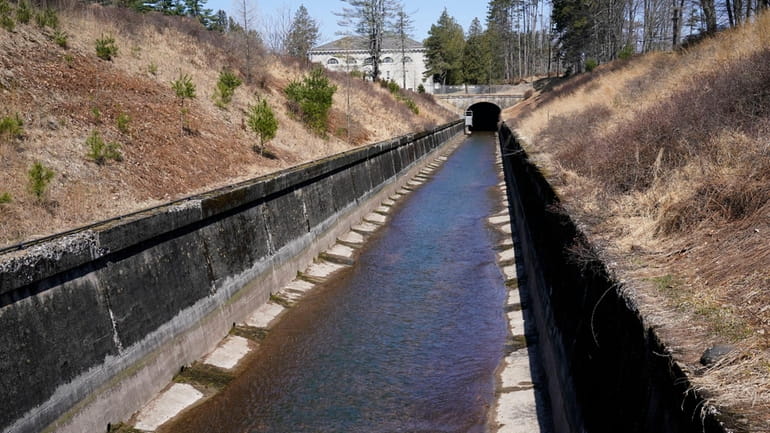Study: 'Water sharing' between NYC, Nassau faces hurdles

Water from New York City's Ashokan Reservoir runs through the release channel in Olive, N.Y. in April 2022. Credit: AP/Seth Wenig
A possible $2 billion project to tap into New York City’s water supply to provide all of Nassau County’s drinking water would face "significant challenges" and could take up to 15 years to complete, although a scaled-down plan is "feasible," according to a new state Department of Health study obtained by Newsday.
The study, which is expected to be released Thursday, examined the possibility of “water sharing” with the city’s upstate reservoirs because of concerns about emerging contaminants in Long Island’s aquifer.
New York City’s water has virtually no nitrates, volatile organic compounds or emerging contaminants while these regulated compounds are widespread and require treatment throughout Nassau County, the 57-page report states.
VOCs are found in household products and cause irritation and other health effects, and in some studies have been linked to colon cancer.
Emerging contaminants include 1,4-dioxane, an industrial solvent and likely carcinogen, and PFOS and PFOA, compounds found in nonstick products and also linked to cancers and other health impacts, according to the federal Environmental Protection Agency.
The study looked at a scenario in which 20 million gallons per day could be delivered through five existing connections near the Nassau/Queens border, along with an option involving major new infrastructure that could pump 180 million gallons per day from city reservoirs.
The study estimates costs of between $35 million and $55 million and a construction timetable of two to five years on the low end, and $1.4 billion to $2.2 billion for a large-scale project that would take 10 to 15 years to complete.
“It can be done,” Dan Lang, deputy director for the DOH’s Center for Environmental Health, said of the most intensive option. “We didn't completely say it's infeasible to do that, just that it would be a monumental feat to make that happen.”
The Water Supply Interconnection Feasibility Study was requested in 2019 by then-State Sen. Todd Kaminsky (D-Long Beach).
The study was designed to examine whether water sharing with New York City could reduce strain on the aquifer serving Nassau, and reduce the estimated total $1.5 billion cost of treating the emerging contaminants.
The study, for which $500,000 was included in the 2021 state budget, said the large-scale option would face “significant challenges” including a limited supply of New York City water, high costs and difficulties involving creation of new water districts.
Study authors said the report does not endorse any scenario and is instead intended to “inform future decisions on the critical issues regarding water supply for Nassau County.”
A spokesman for the state Department of Environmental Conservation, which also worked on the study, said the report, "provides important, science-based information for water districts to evaluate options to continue to provide clean drinking water to Long Island residents."
The study notes that Long Island is one of the few places in the United States where a high-density area lies over a sole source aquifer from which residents obtain their drinking water.
New York City obtains its 1.1 billion-gallons-per-day water supply from a system of aboveground reservoirs.
A 2019 report by the nonprofit New York Public Interest Research Group found Long Island had the most emerging contaminants in its water of any region in the state.
New York City, which has spent billions of dollars protecting watersheds in upstate New York, had the least.
According to the study, New York City produces 200 million more gallons of water per day than it needs, although the overage could disappear by 2040 as demand increases.
Edward Timbers, spokesman for the New York City Department of Environmental Protection, said the agency will review the state study in more detail and have follow-up conversations with officials and water providers on Long Island.
Members of the Long Island Water Conference, which represents about 50 water providers, received the study Wednesday and were still examining its findings.
But the group raised questions about future water rates, supply issues, fluoridation treatment and the precise impact of differences in water chemistry.
New York City adds fluoride to its water supply for dental protection while Long Island providers do not.
“This study seems like a well-intended first step in tackling these concepts, but much more work is needed given the complexity and sensitivity surrounding a change of this capacity,” Long Island Water Conference spokesman Dennis Kelleher said in a statement to Newsday.
Adrienne Esposito, executive director of the Farmingdale-based nonprofit Citizens Campaign for the Environment was briefed on the study Wednesday and said the city’s limited supply likely makes a large scale project not worth the expense.
However, water sharing in areas that are vulnerable to saltwater intrusion such as Long Beach or Port Washington could make sense, Esposito told Newsday.
“The management and treatment of drinking water is going to be one of Long Island's greatest challenges,” Esposito said. “We need to consider all options.”
A possible $2 billion project to tap into New York City’s water supply to provide all of Nassau County’s drinking water would face "significant challenges" and could take up to 15 years to complete, although a scaled-down plan is "feasible," according to a new state Department of Health study obtained by Newsday.
The study, which is expected to be released Thursday, examined the possibility of “water sharing” with the city’s upstate reservoirs because of concerns about emerging contaminants in Long Island’s aquifer.
New York City’s water has virtually no nitrates, volatile organic compounds or emerging contaminants while these regulated compounds are widespread and require treatment throughout Nassau County, the 57-page report states.
VOCs are found in household products and cause irritation and other health effects, and in some studies have been linked to colon cancer.
WHAT TO KNOW
- A new state study says a potential project to replace Nassau County’s drinking water supply with water imported from New York City reservoirs could cost more than $2 billion and take 15 years to complete.
- Such a large project would present “significant challenges,” but replacing a small portion of Nassau's water supply would be “feasible,” according to the study.
- The report was commissioned to examine alternatives to the county's reliance on an underground aquifer.
Emerging contaminants include 1,4-dioxane, an industrial solvent and likely carcinogen, and PFOS and PFOA, compounds found in nonstick products and also linked to cancers and other health impacts, according to the federal Environmental Protection Agency.
The study looked at a scenario in which 20 million gallons per day could be delivered through five existing connections near the Nassau/Queens border, along with an option involving major new infrastructure that could pump 180 million gallons per day from city reservoirs.
The study estimates costs of between $35 million and $55 million and a construction timetable of two to five years on the low end, and $1.4 billion to $2.2 billion for a large-scale project that would take 10 to 15 years to complete.
“It can be done,” Dan Lang, deputy director for the DOH’s Center for Environmental Health, said of the most intensive option. “We didn't completely say it's infeasible to do that, just that it would be a monumental feat to make that happen.”
The Water Supply Interconnection Feasibility Study was requested in 2019 by then-State Sen. Todd Kaminsky (D-Long Beach).
The study was designed to examine whether water sharing with New York City could reduce strain on the aquifer serving Nassau, and reduce the estimated total $1.5 billion cost of treating the emerging contaminants.
The study, for which $500,000 was included in the 2021 state budget, said the large-scale option would face “significant challenges” including a limited supply of New York City water, high costs and difficulties involving creation of new water districts.
Study authors said the report does not endorse any scenario and is instead intended to “inform future decisions on the critical issues regarding water supply for Nassau County.”
A spokesman for the state Department of Environmental Conservation, which also worked on the study, said the report, "provides important, science-based information for water districts to evaluate options to continue to provide clean drinking water to Long Island residents."
The study notes that Long Island is one of the few places in the United States where a high-density area lies over a sole source aquifer from which residents obtain their drinking water.
New York City obtains its 1.1 billion-gallons-per-day water supply from a system of aboveground reservoirs.
A 2019 report by the nonprofit New York Public Interest Research Group found Long Island had the most emerging contaminants in its water of any region in the state.
New York City, which has spent billions of dollars protecting watersheds in upstate New York, had the least.
According to the study, New York City produces 200 million more gallons of water per day than it needs, although the overage could disappear by 2040 as demand increases.
Edward Timbers, spokesman for the New York City Department of Environmental Protection, said the agency will review the state study in more detail and have follow-up conversations with officials and water providers on Long Island.
Members of the Long Island Water Conference, which represents about 50 water providers, received the study Wednesday and were still examining its findings.
But the group raised questions about future water rates, supply issues, fluoridation treatment and the precise impact of differences in water chemistry.
New York City adds fluoride to its water supply for dental protection while Long Island providers do not.
“This study seems like a well-intended first step in tackling these concepts, but much more work is needed given the complexity and sensitivity surrounding a change of this capacity,” Long Island Water Conference spokesman Dennis Kelleher said in a statement to Newsday.
Adrienne Esposito, executive director of the Farmingdale-based nonprofit Citizens Campaign for the Environment was briefed on the study Wednesday and said the city’s limited supply likely makes a large scale project not worth the expense.
However, water sharing in areas that are vulnerable to saltwater intrusion such as Long Beach or Port Washington could make sense, Esposito told Newsday.
“The management and treatment of drinking water is going to be one of Long Island's greatest challenges,” Esposito said. “We need to consider all options.”
Gilgo-related search continues ... Trump hush money trial latest ... Gang member stands trial ... What's up on LI
Gilgo-related search continues ... Trump hush money trial latest ... Gang member stands trial ... What's up on LI

